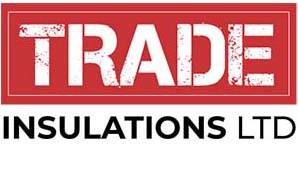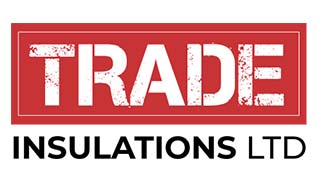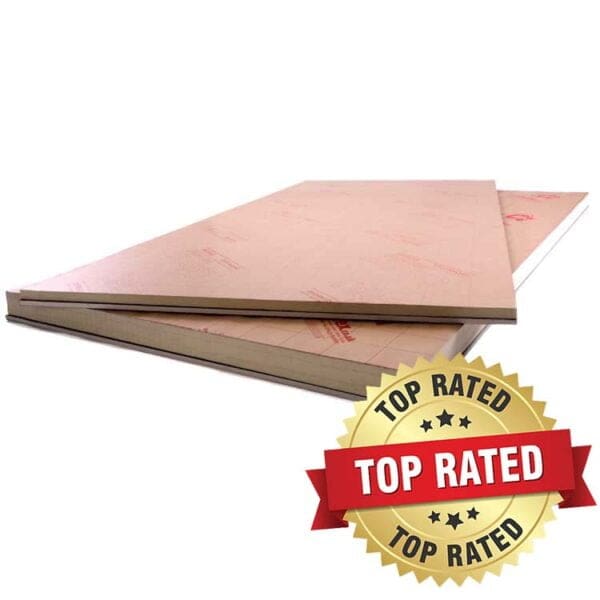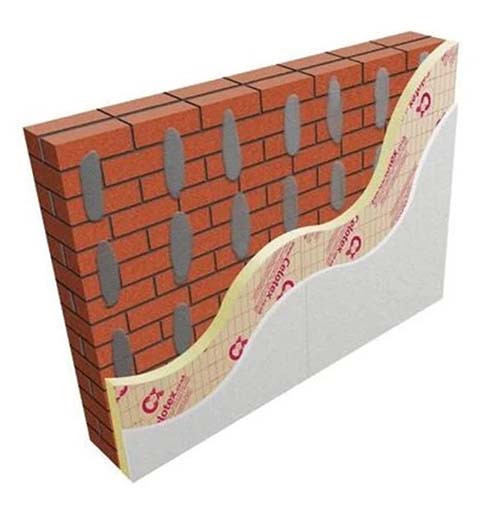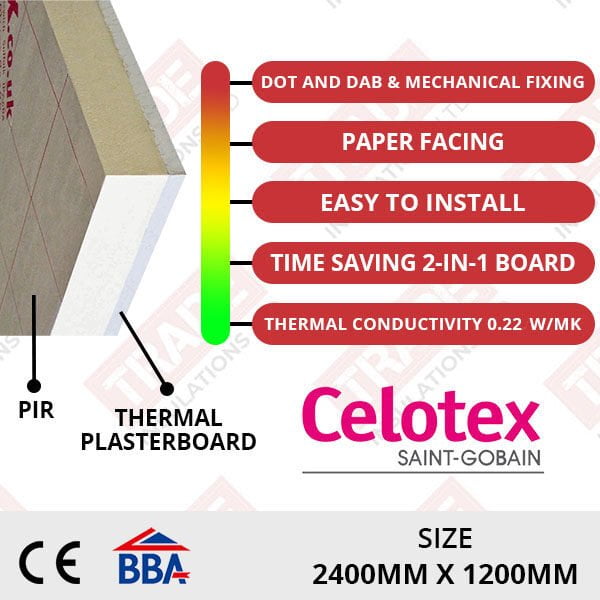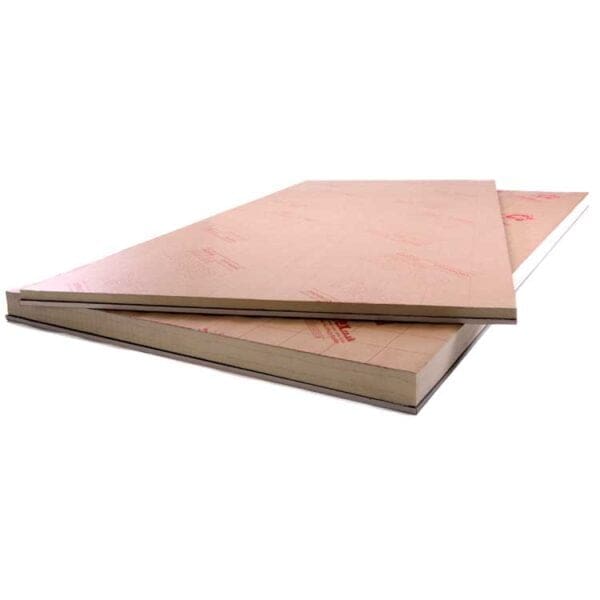Celotex Insulated Plasterboards PL4000
The Celotex PL4000 board is a thermal laminate board with a paper facing, laminated to a piece of 12.5mm tapered edge plasterboard which offers great insulation quality at fantastic values. If you are insulating a garage or a room where the space is minimal the Celotex PL4000 thermal laminate is the ideal insulation board for you.
PL4000 is manufactured from rigid polyisocyanurate (PIR) using a blend of blowing agents that have zero ozone depletion potential (zero ODP) and low global warming potential (GWP).
Showing all 5 results
Celotex 37.5mm Insulated Plasterboard (2400mm x 1200mm x 37.5mm) – PL4025
Original price was: £40.50.£31.90Current price is: £31.90.Celotex 52.5mm Insulated Plasterboard (2400mm x 1200mm x 52.5mm) – PL4040
Original price was: £48.90.£39.91Current price is: £39.91.Celotex 62.5mm Insulated Plasterboard (2400mm x 1200mm x 62.5mm) – PL4050
Original price was: £52.90.£42.90Current price is: £42.90.Celotex 72.5mm Insulated Plasterboard (2400mm x 1200mm x 72.5mm) – PL4060
Original price was: £59.90.£52.00Current price is: £52.00.Celotex 77.5mm Insulated Plasterboard (2400mm x 1200mm x 77.5mm) – PL4065
Original price was: £88.00.£54.99Current price is: £54.99.The Celotex PL4000 thermal laminate board can be fixed using standard masonry fixings and drywall adhesive which is also known as Dot n Dab. The Celotex PL4000 thermal laminate comes in a variety of thicknesses ranging from 25mm to 65mm Celotex.
The PL4000 provides excellent thermal performance. The Celotex boards are light and rigid making transport, handling, and installation easy. The insulated plasterboard is a 2 in1 solution to insulate and dryline walls at the same time at an affordable cost.
With Celotex PL4000 thermal laminate insulation you are specifying an insulation board that:
- Offers the user the ability to install both the insulation and plasterboard in one operation, thus reducing installation times
- It is suitable for both direct bonding (‘dot and dab’) and mechanically fixed installation techniques
- Offers the installer maximum flexibility and installation speed due to the tapered edge plasterboard
- Provides reliable long-term energy savings for buildings
- Is suitable for both new builds and refurbishment projects
- Can be easily used to upgrade to current building regulation standards
- Can be used in pitched roof, flat roof and wall applications
We have a full range of Insulated Plasterboard available on our website.
Please see below our Celotex Insulated Plasterboard datasheet and safety regulations.
Safety:
- Reaction to Fire: Euroclass B-s1, d0 Reaction to Fire classification, according to EN 13501-1
- Achieves a BRE Green Guide A+ rating
- BBA approved – certificate 16/5357 (Plasterboard Thermal Laminate)
- Lambda: 0.022 W/mK
- Facer:12.5mm tapered edge plasterboard; multi-layer composite
- Board Coverage: 2.88m2
- Board / Roll size: Width 1200mm, Length 2400mm
- Thickness: 25-65mm (+12.5mm Plasterboard)
- Material: PIR Plasterboard Laminate
- Paper facing
Datasheet:
| Stocked Thickness | 25+12.5mm | 40+12.5mm | 50+12.5mm | 60+12.5mm | 65+12.5mm |
| Lambda Value (W/m.K) – including plasterboard | 0.022 | 0.022 | 0.022 | 0.022 | 0.022 |
| Length (mm) | 2400 | 2400 | 2400 | 2400 | 2400 |
| Width (mm) | 1200 | 1200 | 1200 | 1200 | 1200 |
| Maximum Weight (kg/m2) | 9.99 | 10.46 | 10.96 | 11.31 | 11.48 |
Celotex Insulated Plasterboard Mechanical Fixing Guide
Before you begin:
- Ensure the wall is sound, secure, free from any contaminants and dry.
- When cutting the insulated plasterboard, it should be carried out by using a fine toothed saw, or by scoring with a sharp knife and then snapping the board over a straight edge and then proceeding to cut the facing on the other side.
- Ensure accurate trimming to achieve close joints and continuous insulation.
Step 1:
Fix timber battens at the floor and ceiling around the room’s perimeter. Then fix further battens to the wall and around any openings or surfaces. Fix each batten approximately 75mm from its end and no more than 600mm horizontal centres.
Each batten should have a minimum depth of 25mm and width of 47mm and backed with a strip of damp proof course.
Step 2:
The installation should start from an internal corner, a window or door reveal.
Insulated plasterboard sheets should always lap the timber battens at the sheet joints. Note the timber noggins may be required where sheets of insulated plasterboard are unsupported.
Ensure each sheet is lightly butted with fixings located no less than 10mm from the bound edges of the sheet. Cut the insulated plasterboard approximately 5mm short of the floor to ceiling height.
Step 3:
Fix the sheet with either drywall screws at 300mm centres or large headed galvanised clout nails at 150mm centres. Fixing should be long enough to allow a minimum penetration into the timber batten or frame.
Drive all fixings straight, with heads embedded just below the surface of the plasterboard.
Step 4:
Lastly, if using plaster to finish. Make your mix as per the instructions then apply to the boarded area and let it dry. Alternatively, you can paint over the plasterboards.
